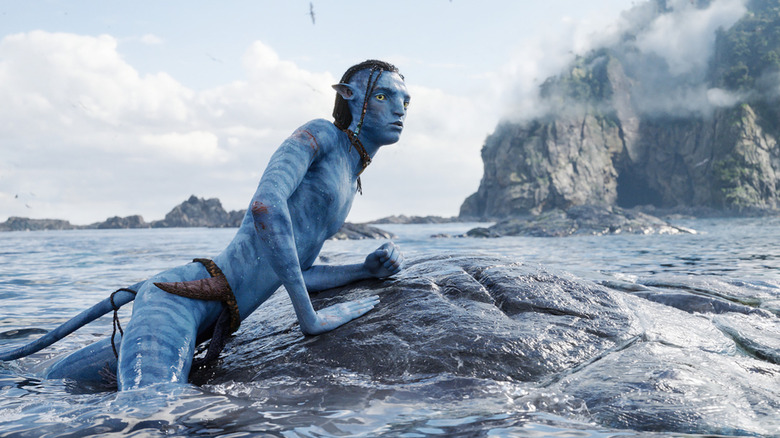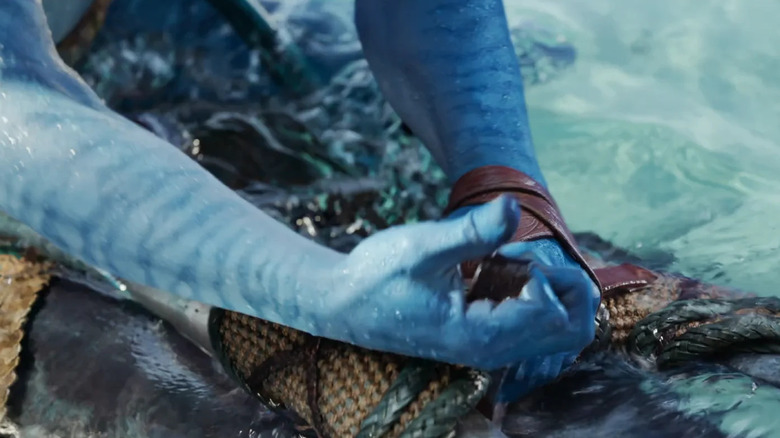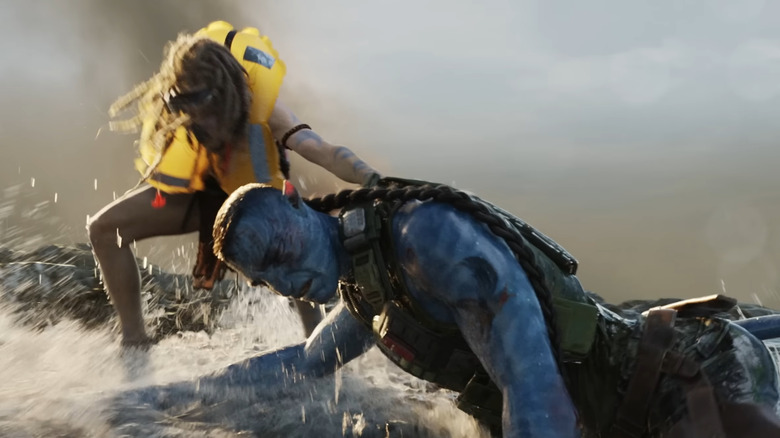Avatar: The Way Of Water's Recent CGI Reveal Has Us Questioning Reality
There's no denying the power of James Cameron. Even 13 years after the first film, "Avatar: The Way of Water" is a massive success, becoming not only the biggest movie of 2022, but the biggest movie since "Avengers: Endgame." It's not hard to see why: This is a giant spectacle of a blockbuster movie, a family epic that smartly handles the "Avatar" story for the next generation, virtually improves on every aspect of its predecessor, and gives us the most expensive save the whales ad ever made.
Just like the first movie, "The Way of Water" is a monumental achievement in visual effects. New tools were created for the film, from water simulators to advances in performance capture, building on what was there from the first "Avatar" but making them bigger and better.
Now that the movie is out, we're finally getting more in-depth looks behind the scenes of the film, especially its Oscar-nominated visual effects. One such behind-the-scenes look finally puts to bed the hottest debate tied to the movie — whether that one shot of Jake cinching a leather strap around his hand was CGI or not.
The magic of VFX
VFX Supervisor Eric Saindon appeared in a recent video from Corridor Crew and finally settled the strap-gate question, which had become more complicated the moment an interview by 1News in New Zealand from last year revealed the strap and the mount from the shot were live-action props. Now, Saindon clarified things, explaining that they did record a live-action version of the shot for reference, then essentially recreated the movement in CGI through rotoscoping. The end result is a shot where only the foreground hand wrapped in the strap is live-action, then everything around it, including the water, is CGI.
What's more, the exciting shot from the "The Way of Water" trailer that everyone was talking about (including yours truly) wasn't even in the final movie! Turns out, they had a different, yet very similar shot done in the same way (mostly CG, with live-action references and the one hand) that didn't make it into the movie but was used in the teaser. One of the reasons the shot works so well and looks so mind-blowingly real is the fidelity of the movements, requiring absolutely flawless capture of the live-action footage.
The way the team did it was they developed a tool to get live depth compositing, using two cameras on the side of the main camera rig and deep learning to map depth so that it can distinguish what CG element is layered where. This meant that the water simulation knows where each g element will be rendered and composited.
Speaking of water simulations, the one Weta uses in this film was taught to distinguish between different water states and how it interacts with things like spray, mist, and flesh. This helped the team render it all at the same time, from the waves, to the texture, and even the tiny little air bubbles underwater.
The artistry of VFX
Perhaps more surprising than the strap shot explanation was the reveal by Saindon of a scene that looked mostly real, but was in fact mostly CGI.
I'm talking about the shot where Spider drags Quaritch out of the water after saving his life at the end of the film, dragging the colonel onto a rock. Apparently, Cameron wanted to shoot that scene in live-action, with Jack Champion (Spider) and a stunt performer for Quaritch, but the desired camera angle was so high it would have clashed with the ceiling of the facility. The solution, then, was to shoot part of the set, using a fake rock, and then replace most of the shot with CGI.
The final shot, then, keeps the rock and the water at the base of Spider's feet, while Spider's legs are replaced with CGI in order to better capture the water interacting with his feet. They also kept Champion's upper half, but replaced only one of his arms with CG in order to get a different grip on the CG version of Quaritch.
Eric Saindon makes it all sound very easy, but of course, it was all super complicated. One thing Saindon doesn't make sound easier was rain. As he explained to Corridow Crew, the one thing Weta's water simulation couldn't do properly was raindrops on people, and how droplets interact with skin, fabric, hair, and other droplets. And because there is a lot of rain in this movie, the team struggled with it a lot, but it is clear they figured it out by the end, because the movie looks stunning.


